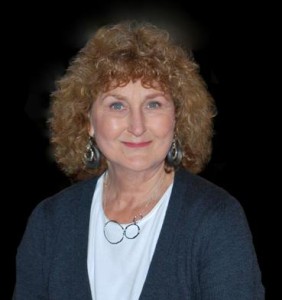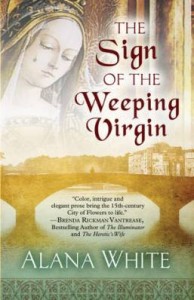~~~~~~~~~~~~~~~~~~~~~~~~~
Confessions of a Research Junkie by Alana White
All right, I’ll admit it: I adore research. And since I am writing a historical mystery series set in Renaissance Italy with real-life women and men like lawyer Guid’Antonio Vespucci, artist Sandro Botticelli, and Florentine leader Lorenzo de’ Medici as main characters, I do a lot of digging, both when planning and when writing the manuscript. Happily, I love the thrill of the chase and the “aha!” moment when I unearth a gem buried deep in the pages of a Renaissance diary, letter, or tax record that sparks a scene, a character’s motivation, or a medieval means of murder.
Apothecary Luca Landucci’s A Florentine Diary is one of my favorite resources. On 25 March 1480 Luca recorded how on that day a religious painting was brought to Florence from a nearby Tuscan town for the spring celebrations. Luca’s note inspired me to “use” that real painting of the Virgin Mary as the one seen weeping in Guid’Antonio and Amerigo Vespucci’s family church, causing all manner of havoc, in The Sign of the Weeping Virgin. Subsequently, during a visit to Tuscany I saw the actual painting for myself, which then led to its description in the book.
In writing this series, I have chosen to stick as close as possible to my Renaissance characters’ real lives, within the realm of what I know. We’ve all heard the saying, “one picture is worth a thousand words.” While researching the Vespucci and Medici families, who were neighbors and close friends, I found that today most historians agree Botticelli’s favorite model, Simonetta Vespucci, and Lorenzo de’ Medici’s beautiful younger brother, Giuliano de’ Medici, were lovers. Giuliano was single and Simonetta was married to Giuliano’s best friend, Marco Vespucci (round and round we go with the Vespuccis and the Medicis!). Well. How to capture and reveal Simonetta and Giuliano’s relationship and, possibly, their feelings for one another?
At last, I saw it in Botticelli’s Primavera (or Spring) painted for Giuliano de’ Medici’s cousin: the emotion on Simonetta’s face as she gazes toward Giuliano on the far left side of the painting is filled with yearning, with longing perhaps unfulfilled. Sometimes, research and serendipity lead to magic moments.
But there is a flip side to this coin. Research is a time-eater. It provides the excuse we writers sometimes use to do anything but continue the hard work of writing our story. Which brings me back around to Lorenzo de’ Medici, who wrote in a poem, “Too much knowing is misery.” Well, it certainly can be. For once we writers have all this fascinating information at hand, whether the details of how autopsies are done, or the particular hue and design of a spectacularly lovely Renaissance dress, how do we keep the information at our fingertips, or at least nearby?
Organization is key. I keep several fat, hardbound notebooks, two of them by subject. Into them I clip any useful general tidbits I find on, say, Renaissance Italian sports. I copy maps and family genealogies and clip them into separate binders. As recommended by popular author and blogger Nathan Bransford, I started a Character Bible, and am I glad I did! Using my bible as a reference, I double-check a character’s description along with the role she/he played in the previous book. Information on poison and means of murder go into their own, separate folders. So—is this micro-management? My hope is that such tactics will help me write through the next first draft with fewer pauses or complete stops along the way, “hope” being the key word here, since I seem to spend a lot of time muttering, “Now, where did I put that notebook?”
How about you? Do you have any tricks or tips regarding research (or any material that is important to you, really) and how to harness it, if not quite wrestle it to the ground?
~~~~~~~~~~~~~~~~~~~~~~~~~
Thanks, Alana. It sounds like an addiction to research is pretty darned important for those who want to write historical novels. I find it hard enough to keep track of each character’s appearance, habits, background, and speech patterns.
For more information about Alana and her work, visit her website.
And please check out these great reviews for The Sign of the Weeping Virgin:
*STARRED* Kirkus Review ~ “One hopes that White’s clever tale, meticulously researched and pleasingly written, is the first in a series that will bring Florence and its many famous denizens to life.”
Publishers Weekly: “Fans of historical mysteries will thoroughly enjoy this chance to visit the Italy of 1480 in the company of real-life historical figure Guid’Antonio Vespucci, a Florence lawyer. Backed up by sure-handed storytelling and scrupulous research into the period, White creates richly evocative descriptions of Renaissance-era Florence certain to please the amateur historian and armchair tourist.”
Library Journal: “Intrigue and danger . . . White’s debut Renaissance mystery is overflowing with historical details and fascinating subplots . . . the author’s knack for describing settings is stellar. Ian Morson writes historicals with a similar tone.”
And don’t forget that any comment on any post this week on this blog gives you another entry for my giveaway of an NCW 2013 writing planner. See the details here.










Hillary, Thank you so much for your comment. I appreciate your thoughts. Interesting to me that you caught that the first book definitely did not come easily:) But you are so right–now I know my characters, and I feel I have more breathing room with them. I’m looking forward to being with them again as I write their next story. If you are interested in a Giveaway for the book, I’ll be doing that for two weeks in mid-February. Here is the link: http://www.hfvirtualbooktours.com/2012/12/alana-white-on-tour-for-sign-of-weeping.html
Hi Pat – what a great guest .. and I love the sound of Alana’s book. Having been to Florence as a young teenager – I need to go back and see it again ..
So interesting to see how you research and learn the ’roundabouts’ you take on your journey ..
I’m not writing a book but check out things .. from my own books, Wikipedia (which I use with care) and then the links across … sometimes the prospective post takes on a different hue – doing that with a book would be a bit of a problem!! My posts are pretty general – but include things I’m not aware of .. or things I think my readers would be interested in – so I learn and they do too …
I love your organisation .. and I’m sure your second book will come more easily .. I’ll definitely be buying this shortly ..
Cheers Hilary
Hi, Shannon, your comments made me smile. I try to be so organized, so I can put my hands on that bit of information that grows in importance depending on how difficult it is to find:) But in the end it all comes from love of the work, right? All good luck with your work. If you aren’t familiar with the Historical Novel Society, you might want to check it out. The next conference is this June (with panels, and agents & editors galore). Here’s the link: http://hns-conference.org
Right now I’m using Scrivener, and I open a file on the side for anything I need to research so I can always refer to it without even exiting the writing program. Love it! However, right now I’m avoiding researching a new novel I want to work on until I’m done with the current one, because I truly am a research junkie, and I’m afraid of just what you said, that I’ll get so sucked into the research that I won’t be writing. Especially as it’s about the Old West, a passion of mine.
Thanks for stopping by!
Shannon at Writing From the Peak
You’re so welcome, Alana. I especially enjoy having authors from Five Star as my guests.
Pat, I just want to thank you for hosting me today. It’s fun. And rewarding.
Hi, Julie, Thanks! Another thing about research: I have found a book now that discusses crime and punishment in 15th-century Italy in Florence. Some of these cases will definitely show up in the next book. In fact, one scenario sparked the actual plot. I find that the deeper I delve into the bibliographies of others, the more real grist I find for the writing mill.
Apologies to everyone for checking in so late, but I’m out of town again to help out with my mom and have limited computer acces. Alana, thanks so much for being here and for monitoring the post for comments.
I’m so intrigued by Alana’s novel and interested in the plot and characters that I can’t wait to read it. It sounds like a very exciting series with excellent research behind the story.
Great ideas and thoughts on researching, and I love to read a book I know is well-researched. It stimulates the mind and the imagination. And yes, art is a wonderful way to gain vivid visuals and kick start the story.
Jacqueline & Bev, Thanks so much for the comments. We all know what a “bear” research can be. It’s like eating popcorn, I can’t quit! Bev, you are so right, I do gather so much from the artwork of the time, clothing details, hair styles, and so much more. And that look Simonetta is giving Giuliano de’ Medici in the painting. So sad, somehow.
Thanks for the post–it summarizes both sides of the research coin well. I also find that good research can hand me plot points I never even thought of. And paintings of interior and exterior scenes can serve as great sources of description.
Hi, Alana and Pat,
I very much enjoyed reading your blog this morning. As a former academic reference librarian, I highly value research. Before I write my novels, I do extensive research as well. Probably TEA LEAVES AND TAROT CARDS was most demanding for me because it’s a Regency romance and readers of this genre are particular in requiring accuracy of historical detail. So much research was required.
I love your idea of keeping a Character Bible. It’s an excellent suggestion. You are clearly well-organized. Congrats on all the wonderful reviews your novel has received.